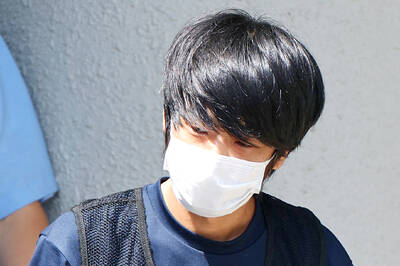As jackets go, it looks far from fashionable, but its Japanese maker cannot meet sky-rocketing demand for “air conditioned” coats with built-in fans.
Kuchofuku Co — whose name literally means “air-conditioned clothing” — has seen orders soar amid power shortages in Japan after the devastating March 11 earthquake and tsunami.
As parts of the nation sweat out an uncomfortable summer shackled by restrictions on electricity use, demand has grown for goods that provide guilt-free respite from the unrelenting summer heat. Two electric fans in the jacket can be controlled to draw air in at different speeds, giving the garment a puffed-up look. However, this has not deterred those happy to be cool rather than “hot” when it comes to fashion.

Photo: AFP
“I work in a very hot place and have to wear long sleeved outfits, so I came over to buy this to stay cool and to prevent heat stroke,” said Ryo Igarashi, 33, as he left the Kuchofuku office after buying an air-conditioned jacket.
Igarashi said the clothing offers him relief at hot construction sites where he, coincidentally, installs air conditioners in buildings. Nearly 1,000 companies in Japan use Kuchofuku.
Among its other products, the company also sells air-conditioned cushions and mattresses that use Kuchofuku’s patented plastic mesh system that allows air to circulate while supporting weight. The products have taken on extra significance since the closure of the tsunami-crippled Fukushima Dai-ichi nuclear power plant and a government decree obliging big companies in the Tokyo and Tohoku regions to reduce power usage by 15 percent to avoid blackouts.
Initiatives such as “Super Cool Biz” encourage employees to ditch jackets and ties and turn down air conditioning, while the power--saving drive has also sparked demand for cooling gadgets. Imports of electrical fans through Tokyo port hit a record high in May.
The fans in the Kuchofuku jacket are connected to a lithium-ion battery pack that lasts for 11 hours on a single charge, consuming only a fraction of the power used by conventional air-conditioning, company president Hiroshi Ichigaya said.
Ichigaya says that his clothing offers a counter-intuitive solution: By wearing more, a person can feel cooler than if baring it all.
Up to 20 liters per second of air circulates throughout the jacket and escapes through the collar and cuffs, drying off sweat and cooling down the wearer.
The idea struck Ichigaya when he was trying to invent an air conditioner that would use little electricity.
“It came to me that we don’t need to cool the entire room, just as long as people in it feel cool,” he said.
Kuchofuku, first launched in 2004, typically draws demand from factories and construction sites, but the company has orders from office workers and housewives.
A standard air-conditioned jacket sells for about ¥11,000 (US$140), with others priced higher.
A central government official recently approached the company to buy 500,000 jackets, but Ichigaya said the company was unable to boost production in time.
The company will sell a total of 40,000 jackets, cushions and other air-cooled products this year, double last year’s figure, Ichigaya said.

With much pomp and circumstance, Cairo is today to inaugurate the long-awaited Grand Egyptian Museum (GEM), widely presented as the crowning jewel on authorities’ efforts to overhaul the country’s vital tourism industry. With a panoramic view of the Giza pyramids plateau, the museum houses thousands of artifacts spanning more than 5,000 years of Egyptian antiquity at a whopping cost of more than US$1 billion. More than two decades in the making, the ultra-modern museum anticipates 5 million visitors annually, with never-before-seen relics on display. In the run-up to the grand opening, Egyptian media and official statements have hailed the “historic moment,” describing the

SECRETIVE SECT: Tetsuya Yamagami was said to have held a grudge against the Unification Church for bankrupting his family after his mother donated about ¥100m The gunman accused of killing former Japanese prime minister Shinzo Abe yesterday pleaded guilty, three years after the assassination in broad daylight shocked the world. The slaying forced a reckoning in a nation with little experience of gun violence, and ignited scrutiny of alleged ties between prominent conservative lawmakers and a secretive sect, the Unification Church. “Everything is true,” Tetsuya Yamagami said at a court in the western city of Nara, admitting to murdering the nation’s longest-serving leader in July 2022. The 45-year-old was led into the room by four security officials. When the judge asked him to state his name, Yamagami, who

DEADLY PREDATORS: In New South Wales, smart drumlines — anchored buoys with baited hooks — send an alert when a shark bites, allowing the sharks to be tagged High above Sydney’s beaches, drones seek one of the world’s deadliest predators, scanning for the flick of a tail, the swish of a fin or a shadow slipping through the swell. Australia’s oceans are teeming with sharks, with great whites topping the list of species that might fatally chomp a human. Undeterred, Australians flock to the sea in huge numbers — with a survey last year showing that nearly two-thirds of the population made a total of 650 million coastal visits in a single year. Many beach lovers accept the risks. When a shark killed surfer Mercury Psillakis off a northern Sydney beach last

‘NO WORKABLE SOLUTION’: An official said Pakistan engaged in the spirit of peace, but Kabul continued its ‘unabated support to terrorists opposed to Pakistan’ Pakistan yesterday said that negotiations for a lasting truce with Afghanistan had “failed to bring about a workable solution,” warning that it would take steps to protect its people. Pakistan and Afghanistan have been holding negotiations in Istanbul, Turkey, aimed at securing peace after the South Asian neighbors’ deadliest border clashes in years. The violence, which killed more than 70 people and wounded hundreds, erupted following explosions in Kabul on Oct. 9 that the Taliban authorities blamed on Pakistan. “Regrettably, the Afghan side gave no assurances, kept deviating from the core issue and resorted to blame game, deflection and ruses,” Pakistani Minister of